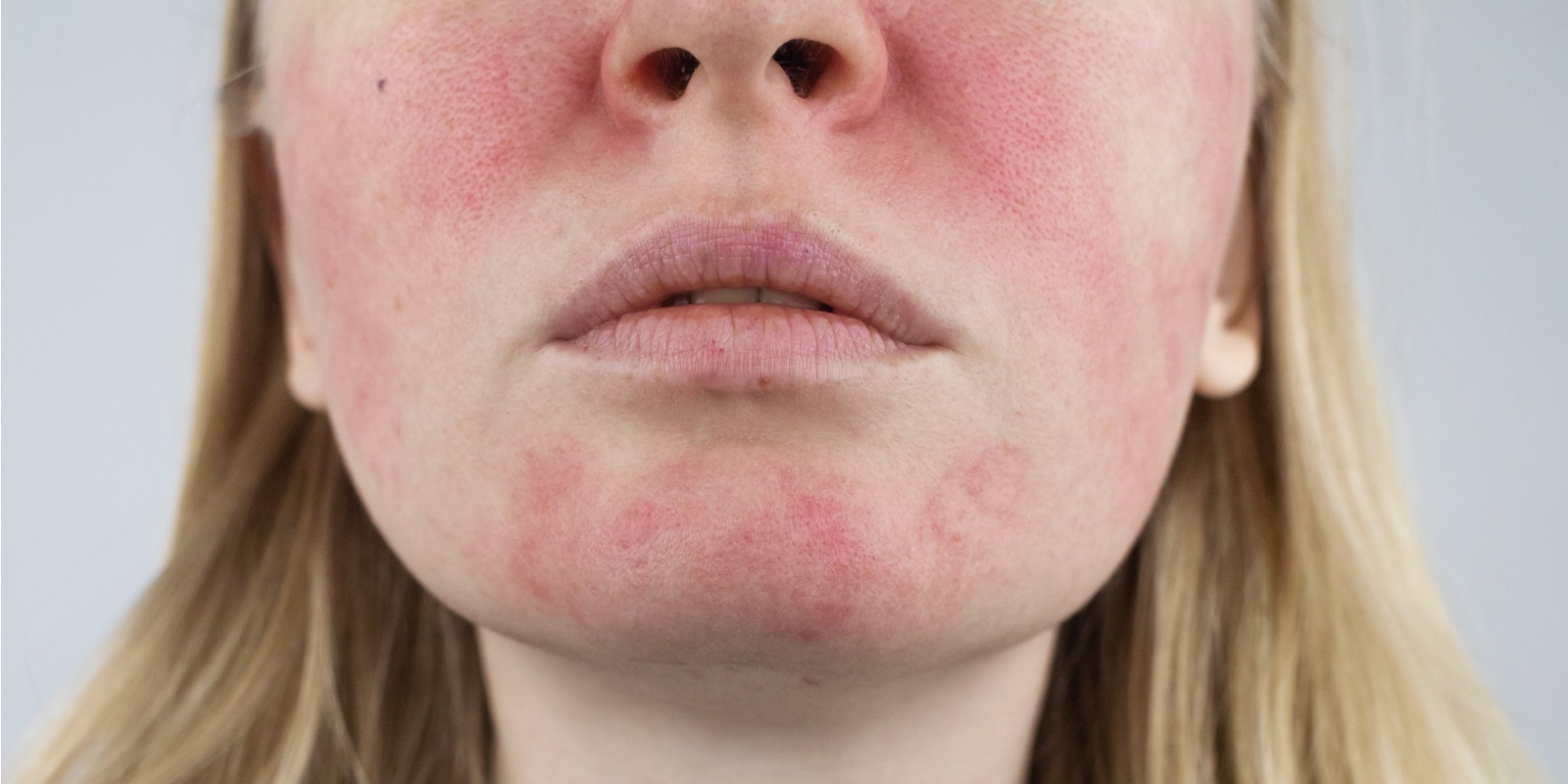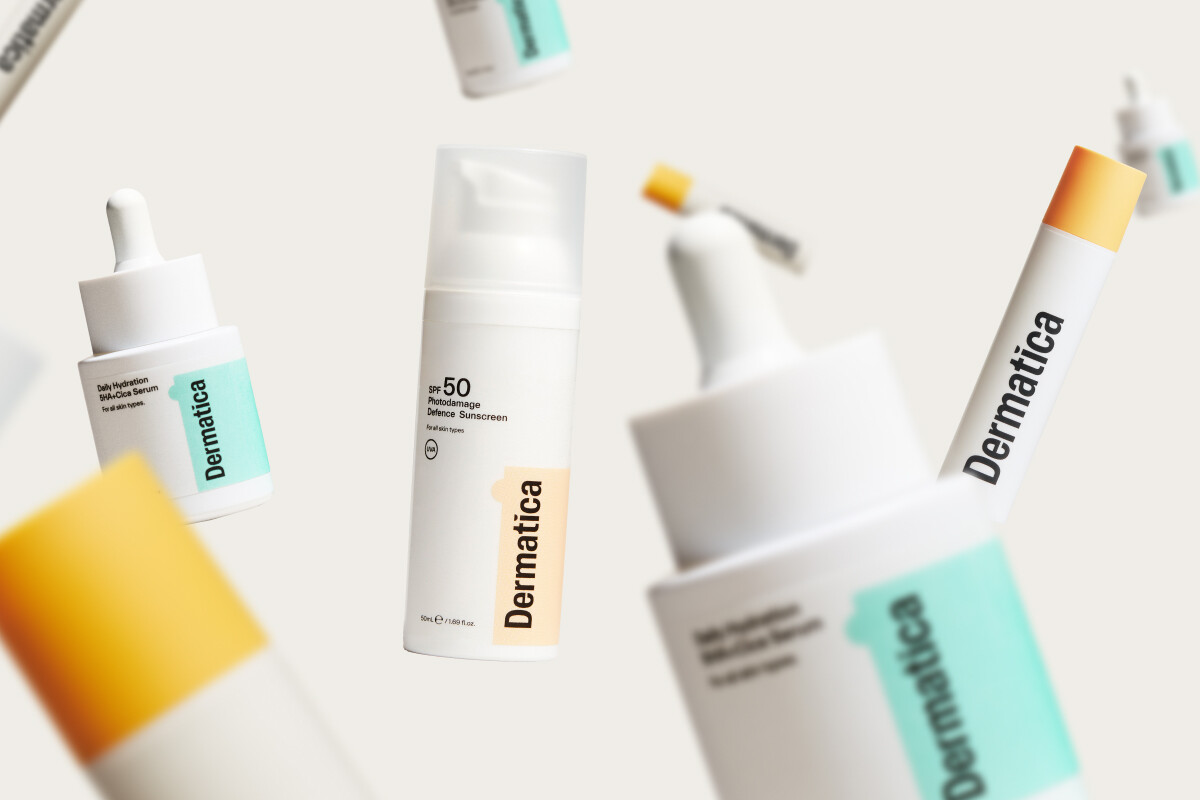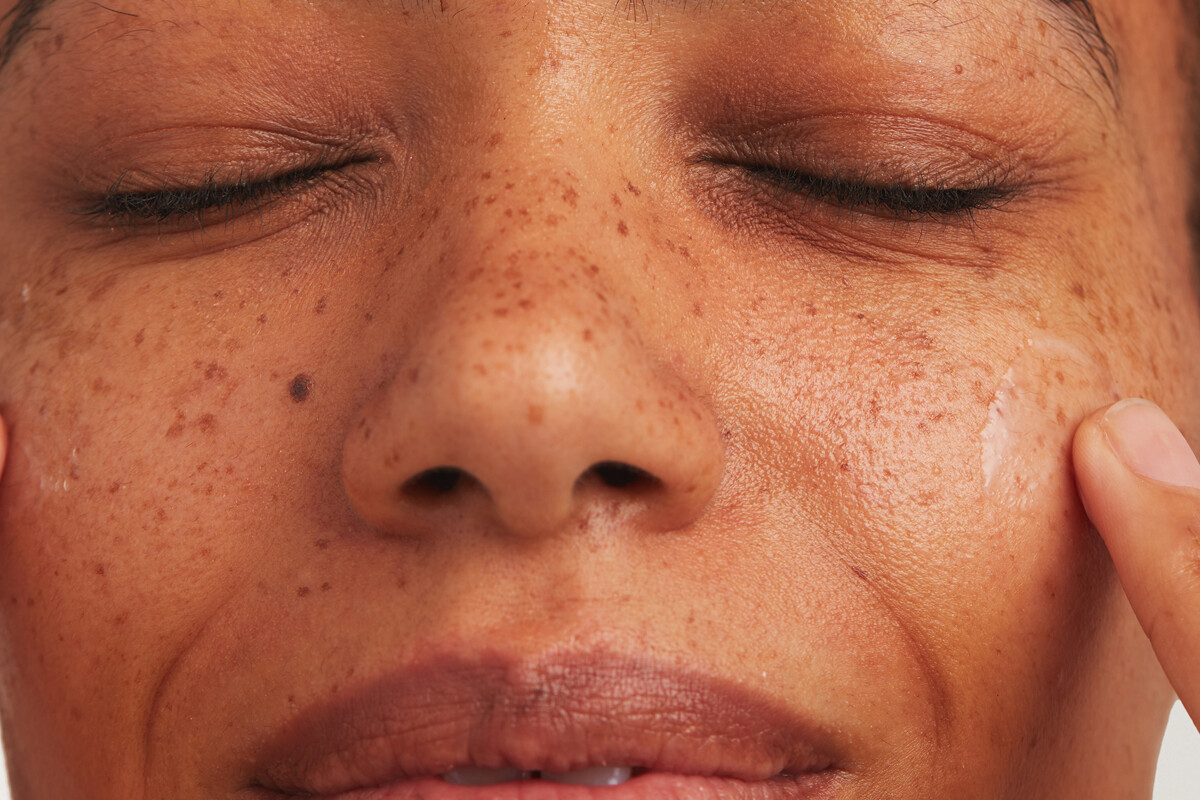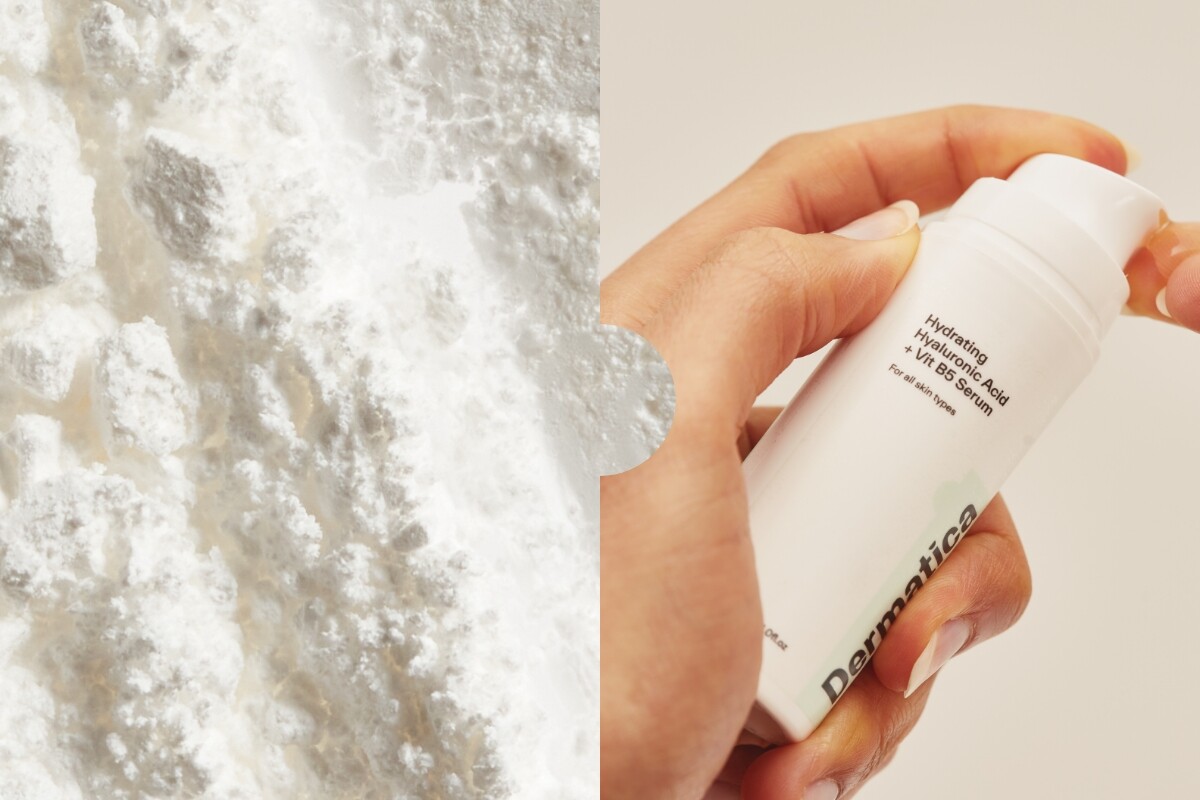Whether you describe it as flares, flushes, or blushing, rosacea is a common skin condition that not only causes your skin to feel highly sensitive – it often brings about unwanted facial redness. Along with this redness, you might also notice skin bumps called papules that look like acne.
If you have rosacea, you may have stumbled across laser treatment, as it’s quickly becoming a popular choice. In this guide, we’ll explore how laser treatments work, the types of lasers used, their benefits, potential risks, and post-procedure skincare routines. We’ll also mention other science-backed options for rosacea, before you try laser treatment, or in case you find that laser treatment isn’t right for you.
What is Rosacea?
Rosacea isn’t just rosy cheeks. It’s a chronic inflammatory skin condition that causes warm, flushed skin across the nose, cheeks and chin. It also makes the blood vessels on your face more visible. It isn’t contagious but, left unmanaged, rosacea can cause thickened skin, eye damage or an enlarged nose. (1)
In the past, it was thought that rosacea only affected people with fair skin or lighter skin. However, those with darker skin can experience it too, but it can be misdiagnosed as hyperpigmentation. If you have darker skin, you’ll want to look for warmth and flushing, including after well-known rosacea triggers like spicy food, hot drinks, sudden changes in temperature or sun exposure. Be mindful if your skin stings or burns after applying certain skincare products, too, as this can also be a symptom of rosacea. (2)
How To Recognise Rosacea
Doctors still aren’t sure what causes it, but they suspect that demodex mites, as well as genetic factors, bacteria and sun damage play a role. (1) Rosacea symptoms may look like:
– Flushing of cheeks, nose, chin and forehead
– Facial redness
– Small acne-like bumps (called papules) on the face
– Dry skin patches
– Enlarged pores
– Swollen nose
– Eyelid bumps
– Eyesight problems
– Red, itchy eyes or swollen eyelids
How Laser Treatment Works
Laser treatment and light-based therapies for rosacea are some of the most effective treatments for a form of rosacea called persistent erythema. This condition is characterised by small visible veins. Laser therapy targets these small blood vessels beneath the skin, so if you’re concerned about visible blood vessels, you may want to consider this treatment.
Laser therapy doesn’t target other aspects of rosacea like the small, acne-like bumps associated with papulopustular rosacea.
The procedure uses a laser to emit a specific wavelength of light, which is absorbed by the red pigment in these blood vessels. This light energy converts to heat, damaging the blood vessel walls and causing them to collapse and be reabsorbed by the body. This process is known as cauterising, and effectively reduces redness and the appearance of any visible blood vessels.
Types of Lasers Used in Rosacea Treatment
V Beam (Pulse Dye Laser – PDL)
– Effectiveness: Particularly effective for treating visible blood vessels, facial flushing and redness.
– Side Effects: Temporary bruising, redness, and swelling.
Intense Pulsed Light (IPL)
– Effectiveness: Good for treating redness, visible blood vessels, and some types of acne-like breakouts.
– Side Effects: Redness, swelling, and light discomfort during treatment
Nd Laser
– Effectiveness: Penetrates deeper into the skin, useful for treating thicker blood vessels and flushing.
– Side Effects: Redness, swelling, and potential for more discomfort. (3)
Benefits of Laser Treatment
If you are considering a laser or light treatment, your results will depend on the dermatologist performing your treatment. The number of treatments you receive should be tailored to your skin by your dermatology expert, based on your rosacea and your needs. These are some of the benefits you can look forward to after laser treatment. (4)
– Reduces Excess Redness: Laser treatment can significantly reduce the persistent redness, flushed complexion and flared skin that comes with rosacea.
– Eliminates Visible Blood Vessels: Lasers can effectively diminish or remove visible blood vessels on the face.
– Long-lasting Results: When used to treat blood vessels, the results tend to last 3 to 5 years. The blood vessels that are treated don’t reappear, but new ones can form.
– Minimal Recovery Time: Most laser treatments don’t require much downtime, allowing rosacea patients to get back to your normal day-to-day life quickly.
Risks and Side Effects
Before undergoing treatment, a dermatologist should go through the side effects of your treatment so that you know the risks. However, generally, these are some potential adverse reactions to keep in mind.
– Temporary Redness & Swelling: A common side effect that usually resolves within a few days.
– Bruising: More common with certain types of lasers, like PDL.
– Discomfort or Pain: How severe the pain or discomfort is will depend on the type of laser treatment you have, and your personal pain tolerance.
– Pigment Changes: On rare occasions, some patients may experience temporary or permanent changes in skin pigmentation.
– Scarring: The chances of this happening is very rare, but still possible if the procedure is not performed correctly. (5)
Safety And Procedure
When treating chronic conditions like rosacea, safety is paramount. As a patient, you’ll need to wear protective goggles during the procedure. The laser or light therapy treatment also has a cooling system, used to protect the epidermis from burns.
Typically, one session isn’t enough, and patients need additional treatment for the full effect. You may need around three to five treatments to achieve long-term results. You may also need regular maintenance treatments, depending on how severe your rosacea is. As well as additional treatments to focus on other symptoms of your rosacea.
Post-Procedure Skincare Routine For Rosacea
You must keep up a gentle skincare routine when you have rosacea generally, but especially after undergoing laser treatment.
Here are some tips from our experts:
– Cooling The Skin: Applying ice-cold compresses to the affected areas can help to reduce pain. Avoiding very hot water and strenuous exercise is also recommended to keep your skin cool.
– Avoid Picking Or Scratching: This helps to prevent scarring.
– Gentle Cleansing: Use a mild, non-irritating cleanser that has no fragrance, comedogenic ingredients or essential oils. Ideally, choose one that’s formulated according to the NICE guidelines for sensitive skin, like our Balancing Glycerin Gel Cleanser.
– Moisturise: Keep your skin hydrated with a gentle, cooling moisturiser like our Soothing Centella Gel Moisturiser. The fragrance-free formulation has centella asiatica and niacinamide to help calm redness.
– Sun Protection: Sun exposure is a well-known rosacea trigger that can cause flare-ups. Avoid sun exposure, and apply a broad-spectrum sunscreen with an SPF of at least 30 every day, like SPF50 Photodamage Defence Sunscreen, to protect your skin from UV damage.
– Take A Break From Cosmetics & Active Ingredients: Using actives in your routine can have powerful effects, but if your skin is recovering from laser treatment, using actives like retinoids or AHAs can cause skin redness, exacerbate irritation and slow down skin healing.
– Avoid Irritating Or Pore-Clogging Ingredients: Steer clear of products with alcohol, fragrance, mineral oils or other potential irritants. (6)
Can Laser Treatments Cure Rosacea?
At the moment, there’s no cure for rosacea. Although it’s an effective treatment, laser treatments aren’t considered to be a permanent cure. The effects are long-lasting – and can last up to a year for some people – but rosacea is a chronic condition, and flare-ups can still happen from sun exposure, stress or certain foods.
How your skin reacts to laser treatments also varies from person to person, but the good news is that generally, benefits can last anywhere from a few months to several years. Many people experience a marked improvement in redness and visible blood vessels for around 6 to 12 months after they get the treatment.
To keep up these benefits, your dermatology professional will often recommend topping up your treatment, depending on how you respond to your initial treatment and how severe your rosacea is. It’s also very important to reduce rosacea triggers and maintain a science-backed skincare routine to prolong the effects of your treatment. (7)
Alternative Science-backed Treatments
A dermatology expert can create a personalised treatment plan with oral treatments, topical creams that include ivermectin, metronidazole or azelaic acid, or a combination of these to help reduce the bumps, pimples, and redness associated with the condition. Taking a course of oral antibiotics such as doxycycline alongside a prescription formula can help speed up your results compared to using a topical treatment on its own.
Whichever treatment path your dermatology expert recommends for you, these should be tailored to match your skin type, treatment goals and where you are on your skin journey.
To find out more about rosacea and our formulas, visit the Dermatica website.
References
1. Information NC for B, Pike USNL of M 8600 R, MD B, Usa 20894. Rosacea: Overview [Internet]. www.ncbi.nlm.nih.gov. Institute for Quality and Efficiency in Health Care (IQWiG); 2018. Available from: https://www.ncbi.nlm.nih.gov/books/NBK279476/
2. Global epidemiology and clinical spectrum of rosacea, highlighting skin of color: Review and clinical practice experience. Journal of the American Academy of Dermatology [Internet]. 2019 Jun 1;80(6):1722-1729.e7. Available from: https://www.sciencedirect.com/science/article/pii/S0190962218325763
3. Galluccio G, D’Onghia M, Dalma Malvaso, Lazzeri L, Cinotti E, Rubegni G, et al. Advances in the Pathogenesis and Treatment of Rosacea: A Phenotype-Based Therapeutic Approach. Cosmetics (Basel). 2024 Jan 17;11(1):11–1.
4. Lasers and lights: How well do they treat rosacea? [Internet]. www.aad.org. Available from: https://www.aad.org/public/diseases/rosacea/treatment/lasers-lights
5. Husein-ElAhmed H, Steinhoff M. Laser and light-based therapies in the management of rosacea: an updated systematic review. Lasers in Medical Science. 2021 Jan 3;36(6):1151–60.
6. Luo Y, Luan XL, Zhang JH, Wu LX, Zhou N. Improved telangiectasia and reduced recurrence rate of rosacea after treatment with 540 nm-wavelength intense pulsed light: A prospective randomized controlled trial with a 2-year follow-up. Experimental and Therapeutic Medicine [Internet]. 2020 Jun 1 [cited 2022 Apr 9];19(6):3543–50. Available from: https://www.ncbi.nlm.nih.gov/pmc/articles/PMC7185073/
7. Loyal J, Carr E, Almukhtar R, Goldman MP. Updates and Best Practices in the Management of Facial Erythema. Clinical, Cosmetic and Investigational Dermatology. 2021 Jun;Volume 14:601–14.
Cat Hyatt
Dr Cat Hyatt is a GP, working as Clinical Content Lead for Dermatica. She has a special interest in medical content and making healthcare information accessible and understandable for all.





